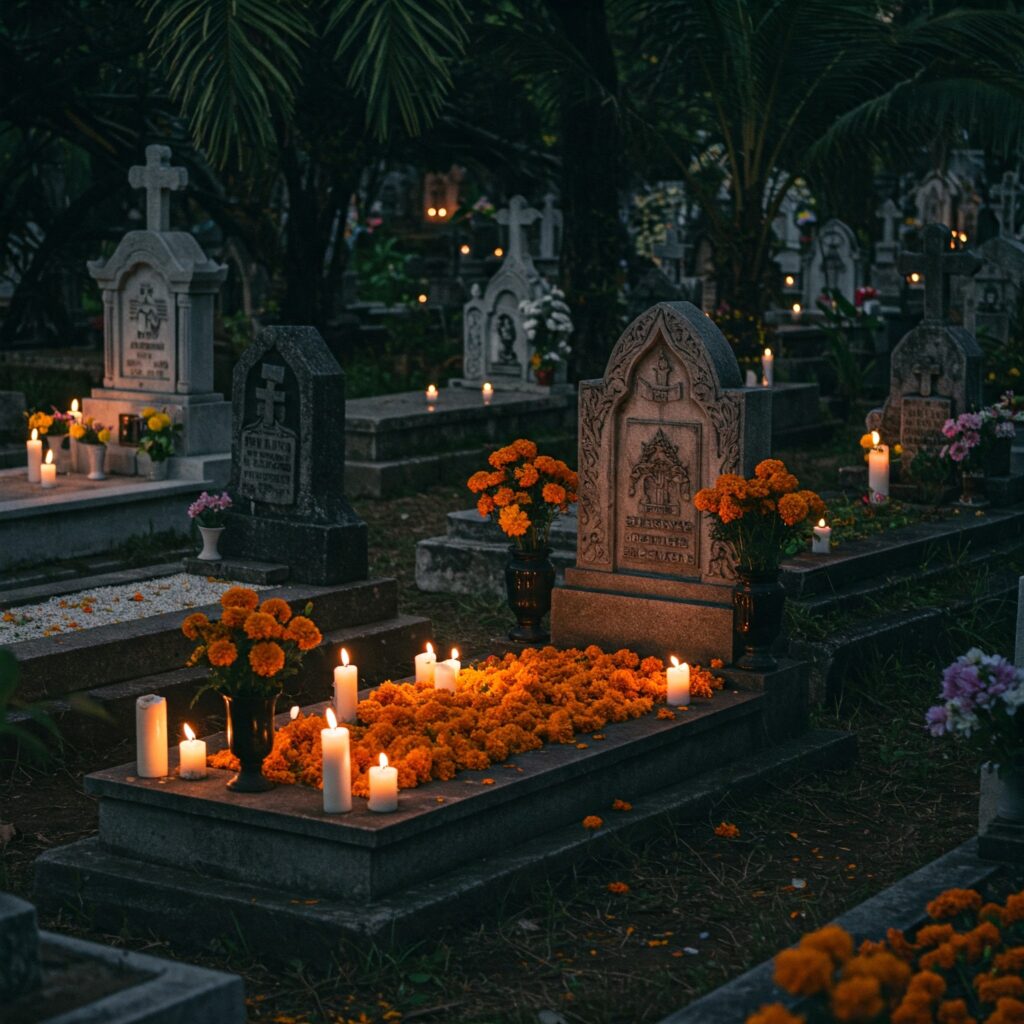The Philippines, a land of vibrant culture and deep-rooted traditions, has a unique way of honoring the departed during All Saints’ Day (Araw ng mga Santo) and All Souls’ Day (Araw ng mga Patay). These holidays, observed on November 1st and 2nd respectively, are a time for families to come together, remember loved ones, and celebrate their lives with a blend of solemnity, joy, and a touch of the supernatural.
So, buckle up as we take a journey through the fascinating world of Filipino traditions surrounding these special days, exploring the customs, beliefs, and the heartwarming spirit of remembrance that makes this celebration truly one-of-a-kind!
More Than Just a Holiday: A Family Reunion with a Twist
Forget Halloween costumes and trick-or-treating; in the Philippines, All Saints’ Day and All Souls’ Day are all about family. It’s a time when Filipinos from all walks of life, whether living in bustling cities or remote villages, make their way back to their hometowns to be with their loved ones – both the living and the departed.
Imagine this: entire extended families, from grandparents to grandkids, gather at cemeteries, transforming them into lively picnic grounds. Tents pop up, laughter fills the air, and the aroma of delicious food wafts through the air, mingling with the scent of burning candles and incense. It’s like a grand reunion, but with the added presence of the dearly departed, making it an experience that’s both heartwarming and otherworldly.
Cleaning House, Literally and Figuratively
Before the festivities begin, Filipinos take the time to prepare their homes and the resting places of their loved ones. Houses are cleaned from top to bottom, symbolizing a fresh start and a welcoming space for the spirits. Gravesites are meticulously cleaned, weeds are pulled, and tombstones are repainted, showing respect and care for the departed.
This tradition of cleaning isn’t just about physical tidiness; it’s about cleansing the spirit and making space for remembrance and connection with those who have passed on. It’s a beautiful way of showing love and respect, ensuring that the memory of loved ones remains vibrant and cherished.
Food, Glorious Food: A Feast for the Senses (and the Spirits)
No Filipino celebration is complete without a feast, and All Saints’ Day and All Souls’ Day are no exception. Families prepare a smorgasbord of delicious dishes, enough to feed an army – or in this case, an extended family and perhaps a few wandering spirits!
From traditional favorites like lechón (roasted pig), pancit (noodles), and lumpia (spring rolls) to sweet treats like bibingka (rice cake) and suman (sticky rice), the spread is a testament to the Filipino love for food and sharing. It’s believed that the spirits of the departed partake in the feast, enjoying the familiar flavors and aromas that once brought them joy in life.
Light Up the Night: Candles, Prayers, and Stories
As dusk descends, cemeteries transform into a sea of flickering candlelight, creating a mesmerizing and ethereal atmosphere. Each candle represents a soul being remembered, a beacon of light guiding their way and symbolizing the enduring love of those left behind.
Families gather around the graves of their loved ones, offering prayers, sharing stories, and reminiscing about cherished memories. It’s a time for reflection, connection, and celebrating the lives of those who have passed on. The atmosphere is filled with a mix of sadness and joy, a poignant reminder of the cycle of life and the enduring bonds of love that transcend even death.
A Night at the Cemetery: Keeping Vigil with the Departed
For some families, the connection with their departed loved ones goes beyond a day visit. They spend the entire night at the cemetery, keeping vigil by the graveside, singing songs, playing cards, and sharing stories. It’s a way of staying close to their loved ones, offering comfort and companionship even in death.
This tradition of staying overnight at the cemetery might seem unusual to some, but for Filipinos, it’s a testament to the deep bond between the living and the dead. It’s a way of honoring their ancestors, keeping their memory alive, and showing that they are still loved and remembered.
Beyond the Feast: Unique Traditions Across the Philippines
While the core traditions of All Saints’ Day and All Souls’ Day are shared across the Philippines, each region has its own unique customs and beliefs that add a local flavor to the celebration.
- Pangangaluluwa: In some provinces, children go door-to-door singing traditional songs called pangangaluluwa, asking for prayers for the souls in purgatory. It’s like a spiritual version of trick-or-treating, with a focus on compassion and remembrance.
- Undas: In some parts of the Visayas region, families build small huts or “undas” near the graves of their loved ones, where they spend the night, offering food and prayers. It’s a way of creating a temporary home for the spirits, welcoming them back to the world of the living.
- Pantawan: In some areas, families set up altars in their homes, adorned with candles, flowers, photos of the departed, and their favorite food and drinks. This tradition, known as pantawan, is a way of inviting the spirits into their homes, sharing a meal with them, and keeping them close during this special time.
A Blend of Traditions: Catholic Faith and Indigenous Beliefs
The Filipino way of celebrating All Saints’ Day and All Souls’ Day is a fascinating blend of Catholic faith and indigenous beliefs. While the holidays are rooted in Catholic teachings, they also incorporate elements of pre-colonial ancestor veneration practices, creating a unique cultural tapestry.
This fusion of traditions is evident in the various customs and beliefs surrounding these holidays, from the cleaning of graves and offering of food to the lighting of candles and keeping vigil at the cemetery. It’s a testament to the resilience of Filipino culture, adapting and evolving while still honoring its roots.
Honoring the Dead, Celebrating Life
All Saints’ Day and All Souls’ Day in the Philippines are more than just holidays; they are a testament to the enduring bonds of family and the Filipino belief in the continuity of life beyond death. It’s a time for remembrance, reflection, and celebrating the lives of those who have passed on, keeping their memory alive in the hearts of those they left behind.
So, next time you’re in the Philippines during this special time, take a moment to experience the unique and heartwarming traditions of All Saints’ Day and All Souls’ Day. It’s a journey that will not only open your eyes to a different culture but also touch your heart and remind you of the importance of cherishing loved ones, both living and departed.
Disclaimer: While we strive for accuracy, cultural practices can vary across regions and families. Please consider this a general overview and feel free to report any inaccuracies so we can correct them promptly.




